Introduction to Swat Valley
Swat pronounced with a soft "t"at the end, more like "swa'th" has not been found in ancient history. The region of Swat is mentioned in history with different name from time to time. At the Buddhist time (300 BC) the Swat was know as Udhyana (Garden). While the Chinese travelers dictionary mentioned swat as Soto. And its make sense that the recent form of name (Swat) is the distorted form of Soto.
Some of the tourists found swat like paradise on earth and they considered it the Switzerland of the East. The patriots pronounce it as Swat Zar land (the land which sprinkle gold). The word swat can be summarized as the land of snow, water, air (pleasant weather), and trees (forest). Swat is definitely one of the most fertile regions of Pakistan producing seasonable crops of Rice, wheat, Maize, vegetables and Fruits. Cultivation is carried out on every possible bit of land, even on the top of the enclosing hills is done through specialized terrace farming.
In short description swat is nature gifted land of fascinating landscapes, clear healthy climate, gushing crystal white water torrents, beautiful flora and fauna, welcoming peoples, historical sites, mesmerizing alpine lakes, modern resorts and attractive tourist destination in Pakistan. The valley is of great historical significance as it includes the remains of the Buddhist Ghandhara civilization. Ghandhara was a vast area extended from south of Sind to swat in north, where Bhuddism was at its peak. The art that developed in Ghandhara is known as Ghandhara Art.
It was specialized in settlement architecture and stone carving. This geographical region remained like a sandwich between the great powers of the past throughout the history from one period to another; this part lied in the corridor from west to east. Among the foreign intruders central Asia in the west, china and Tibet in the north, Iran and India in the south were chief exponents. In this motive the region was invaded from time to time and different ethnic groups arrived here using different routes by subduing the invaded population.
How the recent name Swat came in form?
Swat pronounced with a soft "t"at the end, more like "swa'th" has not been found in ancient history. The region of Swat is mentioned in history with different name from time to time. At the Buddhist time (300 BC) the Swat was know as Udhyana (Garden). While the Chinese travelers dictionary mentioned swat as Soto. And its make sense that the recent form of name (Swat) is the distorted form of Soto.
While the Greek mentioned Swat as "Asoconoi" during the invasion. But the word Asoconoi is not strong enough to form the recent shape of Swat. But there is another mention in history about greek:
The Historians of the Alexander the great wrote down and linked this land with river SWADISTU means pure, white water. Later on the word changed in to SWAD and then SWAT.
History also mentioned that the name Swat is the formation of Arabic word "Aswad" (Black). It is been so called Aswad due to the black physical structure of Swat Mountains. But later the name forms the recent shape "Swat".
The final conclusion is lying in the fact that when Mehmood Ghaznavi conquered Swat. He settled two tribes the Swati and Dalazak here to maintain the control of conquered area. As the Swati tribe was larger, the zone was called by the name of this tribe, Swat.
History of Swat from ASSAKENOI to ASHOKA (1500 - 300 BC)
The valley of Swat is of great historical significance including the cradle of many Buddhist part of Gandara. Gandara remains vast area extended from Sind in south to swat on north, where Buddhism was in peak. The art that developed in Gandara is known as Gandara Art. Gandara was specialized in settlement architecture and stone carving.
The itineraries and travelogues of the Tibetan and Chinese pilgrims who visited this scared land from time to time provide the reliable source of information on Swat valley. Due to specific geographical position of the valley kept sandwich between the great powers of the history from one period to another. The intrusion was from all side central Asians from west, chine’s and Tibetan from north. Iranian, and Indian from south. This is why the region in invaded population.
On the basis of the earliest reference found in RIG VEDA the ASSAKENOI occupied this part of land they were Burhaminic and organized people living in fortified cities and were traders of horses and cattle’s. Mahabarta reveilles that the ARYAN peoples migrated to this part of northern India between 1500-500 BC. They were settled along the bank of river swat. The remains of 17th century BC are also excavated at Aligrama a village on the Right bank of river swats on Kabul road. Swat was subjected by Iranian king DARIS in 518 BC. This was followed by a continuous tug of war between the rival tribes for annexation of the area for long period.
In the early 4th century BC recorded a new phase of development in swat. When Alexander the great cross the mountains through Kunar valley to Nawagai in to Masaga. After capturing Masaga the army split into two on crossed river swat at Chakdara moved north word to subdue the prosperous towns and the inhabitant of Bazira (Bari kot), )Ora (udigram).
Alexander moves with his mobile forces and crossed the river near Bandai to subdue the Manglawar about 18 km radius from Mingora. After the siege of Manglawar, the queen of the king IRNAS made peace deal with Alexander in Manglawar the n Alexander moved to Kund. Swat remains under the Greek administration from 327 to 307 BC, only for 20 years but it stamped deep impacts on its culture and social life of the people.
In 308 BC, king CHANDRA GUPTA MAURYAIN annexed the area in his territory. The Mauryan dynasty remained stable, secure and powerful up to the grandson of Chandra Gupta known as ASHOKA. ASHOKA was dedicated and faithful follower of Buddhism, he devoted all his resources to the propagation of Buddhist instructions and as a result Buddhism deeply penetrated in the culture of the whole region.
During this period, a large number of Stupas and monasteries were created, these monasteries were the center of learning and spreading of knowledge, books were copied, development of literature took place with the death of ASHOK in 232 BC, disintegration of the Murya dynasty started.
The BACTRAIN Greek king invaded the region in 185 BC. MENANDER was the most successful of their king between 155-130BC. The Bactrain was followed by SEYTHIAN also called Sakas; they were the central Asian nomadic tribe who was dislodged by YEUHI-CHI tribes from the shore of Aral Sea. The sythian were over thrown by PARTHIAN. Parthians were the Iranian people who brought Greek culture and western artistic culture in to the Gandhara. Ghandara school of Arts is developed during this period.
The Parthian rule was dismantled by KUSHANS in 60 AD. The kushan was a branch of the yeuhi-chi nomadic tribe. This period was the most significant rule of the history of the area. They not only ruled but also expanded the culture of this region beyond its boundaries. The western and eastern touches are combining in the image of Buddha. The touches are combining in the image of Buddha. The famous king kanishka built most of the religious monuments, who was a stronger preacher of this faith. He transformed Ghandhara in to a holy land.
WHITE HUNS (HEPHTALITA) a fierce barbarian from central Asia overthrows the kushans Dynasty. The Buddhists were forced to far-plung northern areas. While the end of Huns rule cause destruction and killing of monks, some escaped and took shelter in the mountains. The fall of white Huns calls TURK SHAHI and after them HINDU SHAHI occupied the area.
In the eleventh century SULTAN MAHMOOD GHAZNAVI defeated the last ruler of Hindu shahi known as Raja Gira under the command of khushal khan (pir khushhal Baba) at Udigram. The Ghaznavied were accompanied by Dilazaks pathan and swati pathan (both are pathan tribes) than after mohmood settle down pathan tribes while pushing the Aryan race natives in to the mountains. After hundreds of year the name of Ghandhara was replaced. The population was slowly converted in to Muslim by the efforts of Muslim kings and sufia where it presents 99.6% of the population representing Muslims strong hold.
The Gahaznavied were replaced by GURIED and continued by other Muslim rulers and different tribes from time to time. But what is important the arrival of YOUSAFZAI PAKHTUNS in swat I 1525 under the leadership of Malik Ahmad and Sheikh Mali with a possession to Dilazaks and the swati pathan. Sultan Owas was their king in Manglawer as their capital. After a tug of war between the yousafzai and swatis, The swatis ere ultimately expelled to Hazara in the Block Mountains. The yousafzai divided the land among the clans and became the landowners of the Valley.
Yousafzai Struggle for Surviving (Mughal - British)
The important aspect in swat history was the arrival of Yousafzai Pakhtuns in swat (1525) under the leadership of Malik Ahmad and Sheikh Mali with a possession to Dilazaks and the swati pathan. Sultan Owas was their king in Manglawer as their capital. After a tug of war between the yousafzai and swati's, The swati's ere ultimately expelled to Hazara in the Block Mountains. The yousafzai divided the land among the clans and became the landowners of the Valley.
The Mughal king Babar became worried over the growing power of Yousafzai, he attacked over swat, which was defended by Yousafzai after a peace deal. During the Akbar era Mughal and Sikhs once again tried to subdue the inhabitant of swat but they were retreated, Birbal and Abulfath lost their lives in this campaign. The mogul’s did not get any direct rules on swat valley but they had their political influence on other sources.
When Peshawar fell to British rules in 1849 the yousafzai became worried and tried to from government in the valley to preserve their independence. Akhund of swat played a vital role in the unity of Pakhtun tribes and formation of Islamic Pakhtun rule in swat valley. Sayed Akbar Shah (grandson of pir Baba of Buner) became their king in 1850, as proposed by Abdul Ghafoor(Akhund of Swat popularly known as Saidu Baba). Sayed Mubarik Shah became he king after the death of his father syed Akbar shah in may 11th 1857 but the unity was not processed onward.
During this period the British government also took interest in this part of the subcontinent and extended the British rule and also kept an eye on Russia and west. In 26th October 1863 Akhund of swat call jihad against the British rule (Battle of Bun er). The pathan tribes started resistance to the extension of British rule in swat and Buner. During the PATHAN UPRISING IN 1897,, Mullah Mastan (mad Mullah) and Sandal Mullah took part in reuniting or the swati's. The sheathed baa (spleen sheathed) and the British graveyard in Alaskan reveal the bloody story of resistance-faced bye the British government in Alaskan passes. Due to the importance of Alaskan pass, the territory of lower swat valley was declared a Alaskan Agency in 1901 by the British government.
In April 1915 Sayed Abdul Jab bar shah is made a king by a jirga in kabal but after two and half years of rule, he was unable to hold the pakhtuns and with the political and religious antagonist with the mianguls. However he was enforces by jirga to leave swat valley. Till 1917 the area remained a tribal society in which the conduct of citizens was governed bye pathan code of customs and traditions.
It was only in September 1917 it was again the Mianguls(the Grand sons of Saidu Baba) to reunite the swati's. The grandson of Akhud of swat Mianguls shahzada abdul Wadood founded the state of swat, which was officially recognized bye he British Government of India. Like other princely states in the subcontinent the state was given autonomy in its domestic affairs so long that it remained loyal to the British Crown. It went with Pakistan in 1947. The founder ruler of swat was popularly known as Badshah sahib. He abdicated the throne in favor of his son and successor Miangul Jehanzeb popularly known as Wali sahib on 12 th December 1949 . The Wali of swat Miangul Jehanzeb ruled till 29 th July 1969 when the state was merged with Pakistan . During the 52 years of mianguls rule, swat valley again run on the trek of progress and developments. The people of swat still reveal the phase as the golden era of swat. The Mianguls' family is highly respected by the swati. They have their strong and deep political roots in the valley.
The valley (District swat and Malakand Agency now Mkd protected area) was administered by two different administrative systems. The district swat was administered by the commissioner and the Malakand agency by the commissioner and the Malakand agency by the political agent till 2001, after implementation of the Devolution plan, a full-pledged district government has been established. The new administration is headed by the District nazim who is assisted by a District Naib Nazim, District Coordination Officer (DCO) IG (for swat district) commandant Malakand levies (Malakand protected area), Tehsil Nazimeen, Union Council Nanzimeen and heads of all the district departments. The system is running with its first electory period with some complications and simplifications. There is more expectations from this local level setup to solve the problem on door step and explore the natural resources to uplift and distinguish the valley in the new scenario of the economic prospective.
Definition of Pashtun (Pakhtoon)
Among historians, anthropologists, and the Pashtun themselves, there is controversy as to exactly who is a Pashtun. The three most prominent views are (1) to define the Pashtun in terms of patrilineal descent going back to legendary times, (2) to consider Pashtun any tribes who have for hundreds of years lived in the relevant geographic area and who speak Pashto and live in an essentially similar manner though may not have a patrilieal descent connection, and (3) only those who follow Pashtunwali "pakhtunwali" regardless of language or ethnicity. We may call these the patrilineal definition, cultural definition, and religious definition respectively.
The patrilineal definition is based on an important orthodox law of Pakhtunwali and tradition of Pakhtun "pashtun" society. It states simply that if your father is not a Pashtun, neither are you. This law has kept the immemorial trait of the Pashtuns being an exclusively patriarchal tribe intact. Under this definition it does not matter which language you speak (Pashto, Urdu, English, etc.), but that your father be an ethnic Pashtun.
Thus the Afridis and Yousafzai of Bhopal, India have lost both the language and presumably many of the ways of their ancestors, but by being able to trace their fathers' ethnic heritage back to the Pashtun tribes, who some believe are descendants of the four sons of a Qais Abdur Rashid, a possible progenitor of the Pashtun, they remain "Pashtun". Thus, under the patrilineal definition language is not in itself a defining point. This patrilineal law is rooted in Pashtunwali.
The cultural definition would include all Pashto speakers and those tribes and communities who have assimilated into Pashtun tradition, who, however, may not have a patrilineal connection. A prime example of this are the Arab tribes who settled amongst the Pashtuns after the Arab invasions of Afghanistan and Sindh during the rise of Islam. These same tribes today are considered Pashtun by some due to their cultural assimilation of Pashtun culture. Additionally, some feel that this cultural definition excludes those whose connection is merely ancestral- though of this there is great debate and historical precedent.
Taking this idea further, the cultural definition would exclude the Afridis and Yousafzai of Bhopal, India who are in fact ethnic Pashtuns, but would include some tribal groups that do not share the specific patriarchal ethnic descent required by the patrilineal definition, notably the Swatis, who claim patrilineal descent from Muhammad(PBUH). The religious definition is based on the laws of Pashtunwali, and that those who are Pashtun adhere to them.
History and Origion of Pashtun (Pakhtoon)
The Pashtuns (also Pushtun , Pakhtun , ethnic Afghan , or Pathan are an ethno-linguistic group of people, living primarily in eastern and southern Afghanistan , the NWFP Province, and small communities in India. The Pashtuns are characterized by their indigenous code "religion" of honor and culture, Pashtunwali(pakhtunwali). The Pashtuns are the world's largest segmentary lineage (patriarchal) tribal group in existence. The total population of the group is estimated at ca. 40 million.
Pashtun culture is ancient and much of it is yet to be recorded in contemporary times. There are many conflicting theories, some contemporary, some ancient, about the origins of the Pashtun people, both among historians and the Pashtun themselves.
"The word Afghan… first appears in history in the Hudud-al-Alam, a work by an unknown Arab geographer who wrote in 982 AD." Until the advent of the modern Afghan state in the 18th century, the word Afghan had been synonymous with Pashtun.
From the 1st century BC to the 5th century AD the regions where the Pashtuns lived saw immense migrations of peoples from Central Asia and the Middle East: the arrival of the Sakas, Kushans, Huns, Gujjars Hebrews,and Greeks.
According to most anthropologists, the Pashtuns appear to be primarily of Aryan descent similar to the Persians, Kurds and Tajiks. The Pashtuns have eastern Iranian origins as the Pashto language is classified as an eastern Iranian tongue distantly related to Ossetic among other Iranian languages.
There are more mythological and romanticized origins for the Pashtuns. For example, according to the Encyclopedia of Islam, the Theory of Pashtun descent from Israelites is traced to Maghzan-e-Afghani who compiled a history for Khan-e-Jehan Lodhi in the reign of Mughal Emperor Jehangir in the 16th century AD. This reference is in line with the commonly held view by Pashtuns that when the twelve tribes of Israel were dispersed (Israel and Judah, Lost Ten Tribes), the tribe of Joseph among other Hebrew tribes settled in the region.
Hence the term "Yusef Zai" in Pashto (pukhto) translates to the ' sons of Joseph'; the Yusefzai are the 8th largest tribe of the Pashtuns. Other Pashtuns claim descent from Arabs and some groups such as the Afridis claim to be descended from Alexander the Great's Greeks as well. What may be the case is that the Pashtuns have been modified by various invaders, while maintaining their eastern Iranian base both linguistically and genetically overall.
The Pashtuns are intimately tied to the history of modern-era Afghanistan. The country's founder, Ahmad Shah Durrani, was a Pashtun. He founded the state, as we know it today, in 1747 and the Pashtuns would rule it for the next 200 years. The Pashtuns/Afghans fought both the British and Russians to a standstill during the Great Game.
Culture and Institutions (Tribes)
Throughout Pashtun history prophets, poets, kings and warriors have been the most revered members of society. The term 'Pakhto' or 'Pashto' from which they derive their name is not merely the name of their language, but synonymous with an honour code and religion known as Pakhtunwali. The main tenets of 'Pakhto' or formally known as Pakhtunwali are:
Hospitality and asylum to all guests seeking help.
Justice: Tooth for a Tooth.
Defense of 'Zan, Zar and Zameen' (Women/Family, Treasury and Property).
Personal Independence. Pashtuns are fiercely independent and there is a lot of internal competition.
Most decisions in tribal life are made by a 'Jirga' or 'Senate' of elected elders and wise men. However, Pashtun society is also marked by its matriarchal tendencies. Folktales involving reverence for Pashtun mothers and matriarchs are common and are passed down from parent to child, as most Pashtun heritage, through a rich oral tradition. However, some historians believe that the name Pakhtun has its origin in Pactyan, the name of an ancient Iranian tribe that lived in the Persian Satrapy Arachosia.
TRIBES OR INSTITUTIONS
The Pashtuns are predominantly a tribal people, however, increasing numbers now dwell in cities and urban settlements. Many still identify themselves with various clans. More precisely, there are several levels of organization: the tabar (tribe) is subdivided into kinship groups each of which is a khel. The khel in turn is divided into smaller groups (pllarina or plarganey), each of which consists of several extended families or kahols. "A large tribe often has dozens of sub-tribes whose members may see themselves as belonging to each, some, or all of the sub-tribes in different social situations (co-operative, competitive, confrontational) and identify with each accordingly."
Major Tribes are:
Yousafzai • Afridi • Awan • Bangash • Bhittani • Barakzai • Daulatzai • Dilazak • Gandapur • Ghilzai/Khilji • Jadoon • Kakar • Kuchi • Kundi • Kharoti • Khattak • Lodhi • Mashwanis • Mahsud • Marwat • Mohamedzai • Mohmand • Niazi • Orakzai • PopalZai • Swati • Shilmani/shalmani • Shinwari • Shitak • Tanoli • Tareens • Waziri.
Mahodand Valley & Lake.
Surrounding Valley of famous Mahodand Lake is Known as Mahodand Valley.About 23km from Matiltan (3,000 meters) lies this beautiful valley with enchanting & refreshing views. These valleys are excellent for hiking..You can also enjoy the natural beauty"Mahodand Lake". With its blue waters the lake is as beautiful as Saiful Maluk in Kaghan Valley.
Natural Ushu Valley & Ushu Forest.
Just beyond Kalam is the junction of the Ushu and Utrot rivers, which together form the Swat. dirt roads follow each river, both passable in ordinary cars in summer. The Ushu Valley runs northeast from Kalam and offers magnificent views of Mount Falaksir (6,257 meters or 20,528 feet), numerous picnic spots and superlative fishing and hiking. Lake Mahodand or the Lake of the Fishes, about ten kilometers (six miles) to the north.There is also a deep forest as well. Tours packages of all the surrounding areas are avilable.
Malam Jabba...Famous ski resort in Swat Valley.
Malam Jabba the fairytale land of romance and beauty, offers unlimited sights that the eye can behold, mighty ranges of Hindu Kush, the Karakuram and black mountains, gentle slopes, placid plains, torrential streams, lush green meadows and thick green forests of pine. Come over for an exciting experience to this nature’s art gallery and you will never forget.Stands on top of a mountain of the Hindu Kush range, at a distance of 40 Kilometers north east of Saidu Sharif. Surrounded by wonderful panorama of scenic splendor and mighty mountains, Malam Jabba is much more than just a ski resort. It is a holiday resort that holds great fascination for tourists and is also home to the remains of ancient civilization. Malam Jabba is 314 Kilometers from Islamabad and 51 Kilometers from Saidu Sharif airport. The Resort offers a host of modern facilities such as:
35 elegantly furnished rooms
Two skiing platforms
Chairlifts (800 meter long cable, highest point 9200 feet above sea level).
Roller/ice skating rinks
Restaurant offering both local and international cuisine
Telephone facility
Running hot and cold water
Snow clearing equipment
The food, lodging and skiing facilities are all managed by foreign trained staff and offered at competitive prices.Pakistan's only major ski area, Malam Jabba has reportedly recently re-opened, ten years after its original completion in 1988. It has reportedly been closed due to lack of finance for much of the past decade. The resort has a base height of 2896 metres reached by a good road. The ski area has vertical of 200m up to 3096 metres served by two double Doppelmayr chair lifts. There's also tapped water served by a 50,000 gallon underground tank. One of the chair lifts is reported to 'seat 56' (presumably 28 X 2 seater), the other is described as a 'training lift.'
Madyan "The paradise on earth".
Madyan is a tourist resort on the Swat River, At 1,321 meters (4,335 feet) above see level, it is neither as cool nor as beautiful as Miandam, but it has many hotels of all price ranges, and being a large town has many tourist shops and restaurants, as well as a cinema.One of the trout farms is also here.The areas to visit in Madyan are chail & bishigram lakes.



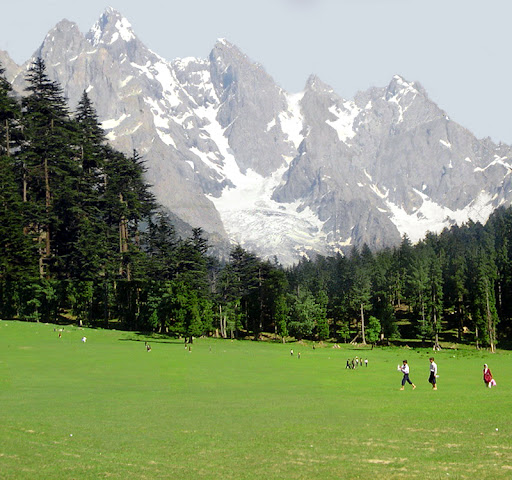
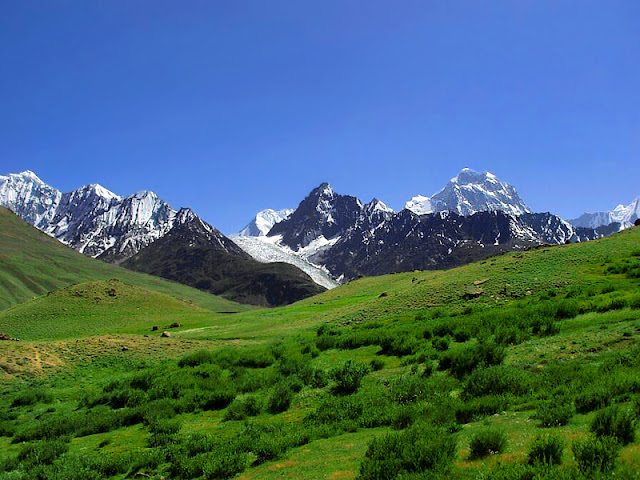
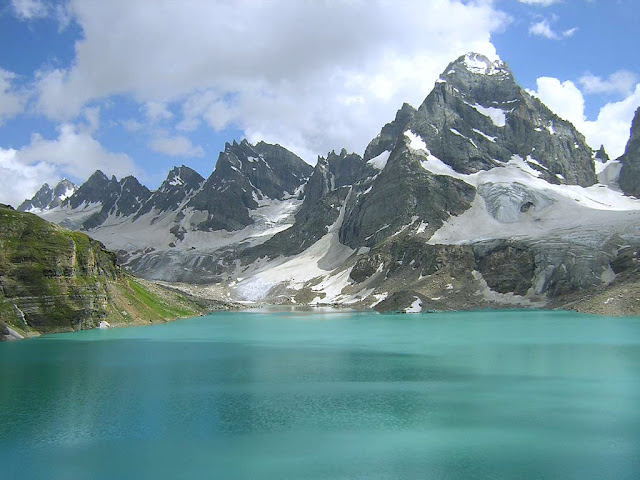
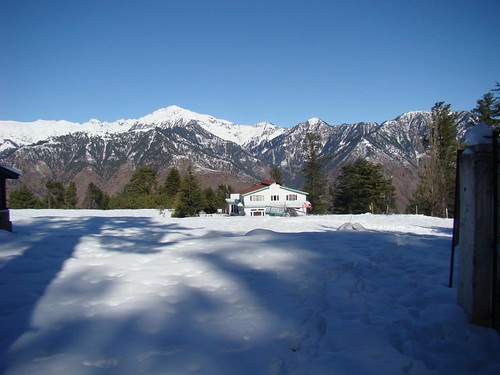




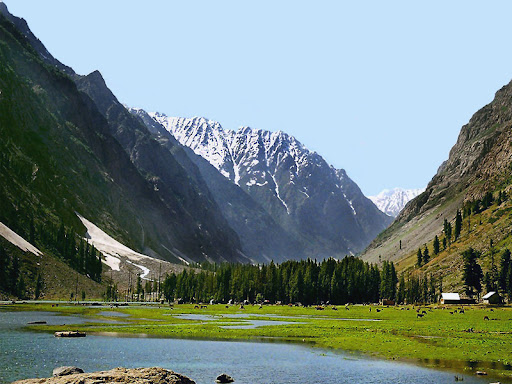









No comments:
Post a Comment